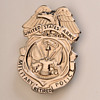Posted 10 years ago
 Chrisnp
Chrisnp
(310 items)
In 1914 Canada was a country of only about eight million people with a regular army of 6,000 plus militia. By the end of the war, over 619,000 Canadians would enlist. 66,655 wouldn’t come home. The infantry was raised in numbered battalions, each with their own cap badge.
1. This Canadian General Service Cap badge is a particularly nice example. The back is marked “Birks” and the year “1915”. The lugs on the back are made from flattened metal, as opposed the more commonly encountered wire loops.
2. The 87th Battalion, Canadian Grenadier Guards was recruited in Montreal and arrived in France in 1916 and saw action at the Somme, Vimy Ridge, Passchendale and elsewhere. Their badge has the royal cypher interlaced and reversed over the word “CANADA” In this case it’s almost worn smooth. This came to me on an unsalvageable trophy belt with other WWI era badges.
3. The 27th (City of Winnipeg) Battalion bears the coat of arms of the city. During the battle of St Eloi, the Commander of the 27th stayed awake for six straight days trying to relieve the strain “on his beloved boys”. After the battle he broke down and cried and was later diagnosed with shellshock. I purchased this particular badge to display with the 27th Battalion items posted here:
http://www.collectorsweekly.com/stories/42263-memorabilia-for-the-27th-winnipeg-battal
4. This is the shoulder title of the Seaforth Highlanders of Canada. During WWI they deployed as the 72nd Battalion CEF. At Vimy Ridge, the 72nd helped spearhead the attack. After the battle, only 11 officers and 62 men remained. This particular piece was brought to the States after WWI as a keepsake by an American Doughboy from the 109th Infantry Regiment.
5. The Fort Gary Horse would organize the Canadian Cavalry Depot and Overseas Training Depot in Britain. It also deployed to France and Flanders where it fought as part of the Canadian Cavalry Brigade. This unit also served in WWII as an armored regiment, but I think this may be an earlier vintage due to the unusual slider style attachment with an upward bent tab.
6. The 32nd Battalion, CEF was recruited in Manitoba and Saskatchewan and embarked for Britain in January 1915. There it was absorbed by the 15th Reserve Battalion to provide reinforcements for the Canadian Corps in the field. This badge was fitted with a slider that got broken off at some point.















Well covered history Chris. Am I the only one to notice that the Brits almost always sent the "colonials" into the suicide situations? A shame.
I could list a lot of British units that took a horrendous beating too, Blunder, but this post is about Canada.
Thanks for the love, Roycroftbooksfromme1, Blunder and bratjdd.
I notice only three "Loves". I wonder if people are getting tired of my enthusiasm for British cap badges. Bear with me. I only have a few more to post, then on to something else.
In a small town back east i visted there was a memorial to 94 men in a town of 1100 residents volunteered for WW1 none returned. Every person in the town was greatly affected.